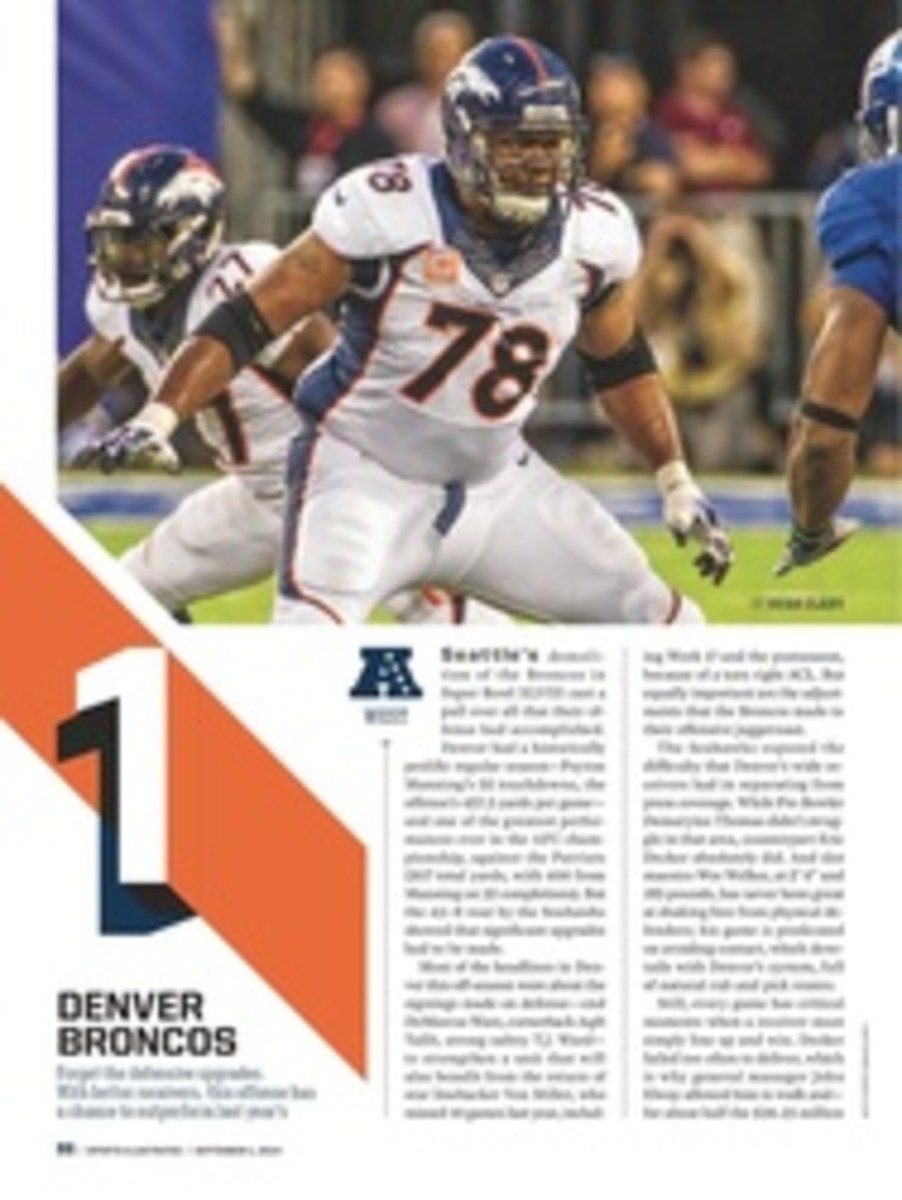
2 MIAMI DOLPHINS
You may have heard: The Dolphins had a little trouble with their offensive line last year. But as wretched as things were in the locker room (see: Richie Incognito, Jonathan Martin), they were just as bad on the field. Quarterback Ryan Tannehill got slapped around incessantly and was sacked 58 times, 10 more than the next-most-battered QB, Joe Flacco. A sack total like that can be the sign of an inexperienced quarterback's not knowing where to go with the ball. But that wasn't the case in Miami; the line was just that bad.
Not surprisingly, new GM Dennis Hickey immediately overhauled the front five. He signed Chiefs left tackle Branden Albert for five years at $47 million ($20 million guaranteed) to replace Martin; bookended him with Ja'Wuan James, the No. 19 pick, out of Tennessee; and shelled out $5.5 million over two years for free-agent guard Shelley Smith, an underrated run blocker from St. Louis. The other guard spot will be filled by either last year's third-round choice, Dallas Thomas, or late off-season pickup Daryn Colledge. The only holdover starter, Pro Bowl center Mike Pouncey, will miss at least the first month of the season after tearing a hip labrum during OTAs.
Those are some serious personnel maneuvers—although Hickey might have been able to get away with less drastic ones. That's because Miami will automatically get a boost up front from the no-huddle spread system that's been installed by first-time coordinator Bill Lazor, who was Chip Kelly's quarterbacks coach last year in Philadelphia.
Here's a key reason that Kelly's scheme will go viral in the NFL: It naturally minimizes the impact of the offensive front. O-line versus D-line on passing downs is the biggest mismatch in football—it's absurdly difficult for a 320-pound offensive tackle to contend with a quick, 260-pound defensive end. This becomes particularly problematic on seven-step drop-backs, when blockers must provide their quarterback with even more time to throw.
But in a no-huddle spread most of the passing designs ensure that every eligible receiving target is a viable threat, giving a quarterback five places to throw. The ball comes out quickly—often on a three-step drop, sometimes on a one-step drop. As long as the linemen don't completely blow their blocks, it's almost impossible for a pass rusher to reach the quarterback in time. And since a middling lineman will suffice, the front office can spend its money on other positions.
One position the Dolphins have already invested in is wide receiver. The previous regime gave Mike Wallace $30 million in guarantees last year, which makes him wildly overpaid. The 28-year-old speedster has said he's excited about being used in a variety of ways under Lazor—though if he were truly capable of flourishing in myriad roles, his previous coaches in Miami and Pittsburgh wouldn't have limited him to running outside fly patterns.
Good thing the Dolphins have a wealth of other options. Sixth-year receiver Brian Hartline led Miami in catches (76) and yards (1,016) last season and was even treated by some defenses as Miami's primary threat. Given his well-rounded route running, don't be surprised if he leads the team again. Second-round rookie Jarvis Landry (LSU) will compete for No. 3 duties with big, smooth interior-possession target Rishard Matthews and up-and-coming Brandon Gibson (who returns from a left-ACL injury). Then there's tight end Charles Clay, one of the league's most versatile players, who's effective coming out of the backfield or split wide.
The man charged with getting the ball to that group, the 26-year-old Tannehill, has developed commendably over his first two seasons. He has proved to be effective on the move, which will serve him well in the read-option and in the rollouts featured in Lazor's scheme. He's also a sound (and developing) decision maker. Tannehill's only glaring weakness: his deep ball, which often has too much air under it.
Sometimes that has to do with a young quarterback's bracing to get hit. But that shouldn't happen as often to Tannehill, operating behind a new offensive line and under a new system that, if successful, will create a new culture in Miami.
2014 SCHEDULE
2013 Record: 8--8
WEEK 1
NE [HOME]
BUF [AWAY]
KC [HOME]
OAK LONDON
BYE
GB [HOME]
CHI [AWAY]
JAX [AWAY]
SD [HOME]
DET [AWAY]
BUF THUR [HOME]
DEN [AWAY]
NYJ MON [AWAY]
BAL [HOME]
NE [AWAY]
MIN [HOME]
NYJ [HOME]
WEEK 17
FOCUS ON
The cornerbacks
Defensive coordinator Kevin Coyle spent four years as a Bengals assistant under Mike Zimmer (who now runs the show in Minnesota), and he shares his former boss's affinity for coverage disguises and rotations. If executed properly, those can be the best way to get a secondary to overachieve. Just as Zimmer had two retread cornerbacks with the Bengals—Terence Newman and Adam Jones—Coyle has Brent Grimes and Cortland Finnegan. Grimes, 31, recently earned a new four-year, $32 million contract by bouncing back from a 2012 Achilles injury with a Pro Bowl year. He's an excellent leaper, which can offset his diminutive stature. He's also erudite in individual coverage technique. The same can be said of Finnegan, though the 30-year-old must bounce back from a deplorable '13 season in St. Louis. If he regains his form, Finnegan is an excellent nickel slot defender and a blitzing threat—something the creative Coyle will certainly use to great advantage.
THE CASE FOR
Defensive end Olivier Vernon
If you watched the Dolphins last year, you most definitely heard Vernon's name called often. The second-year end from Miami finished with a team-leading 11½ sacks, tied for third in the AFC, and he was even more adept at run stopping. The 6' 2" Vernon moves with natural fluidity and—though listed at a modest 268 pounds—brings a respectable bull rush from the right side. He also benefits from playing on a line that has quietly developed into one of the best units in the NFL. Inside, hybrid players Jared Odrick and Randy Starks offer tremendous combinations of strength and quickness, allowing them to consistently shed blocks. On the opposite side, Cameron Wake is regularly among the league leaders in both sacks and holding penalties drawn. And Miami's most gifted lineman may be backup end Dion Jordan, the third pick in the 2013 draft, who can be used off the edge and as a spy in coverage—that is, when he's back from a four-game PED suspension. The Dolphins should survive Jordan's absence just fine. Vernon may not be quite as athletic as Jordan, but that hasn't hampered him yet; after playing a reserve role as a rookie, he proved last year to be quite a handful for blockers.
PHOTO
BRAD PENNER/USA TODAY SPORTS
WR BRIAN HARTLINE
PHOTO
JC RIDLEY/CSM
NINTEEN PHOTOS

